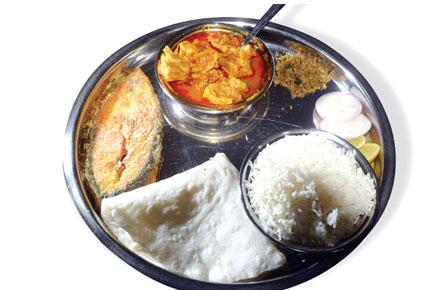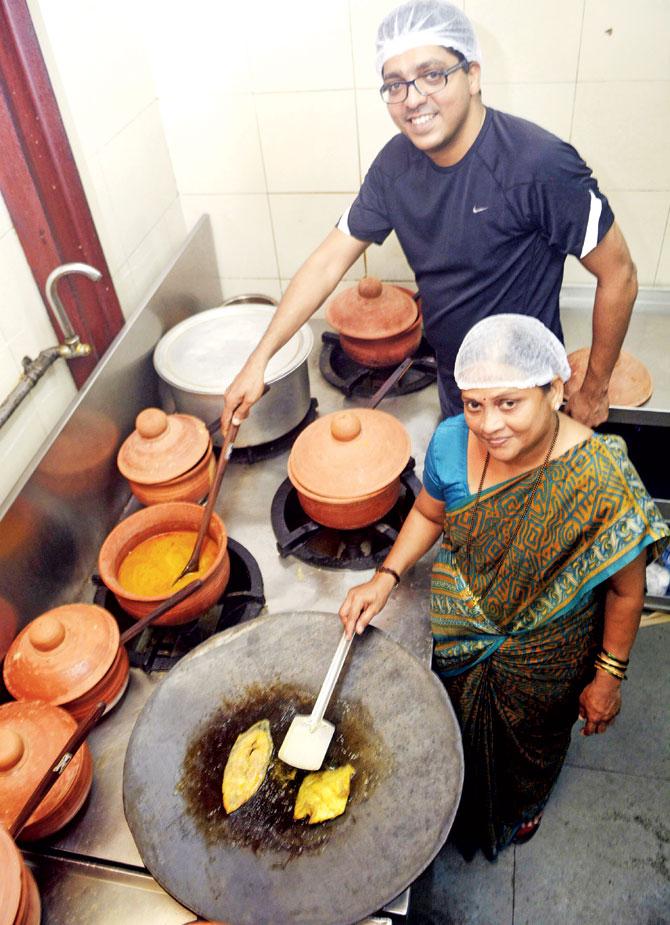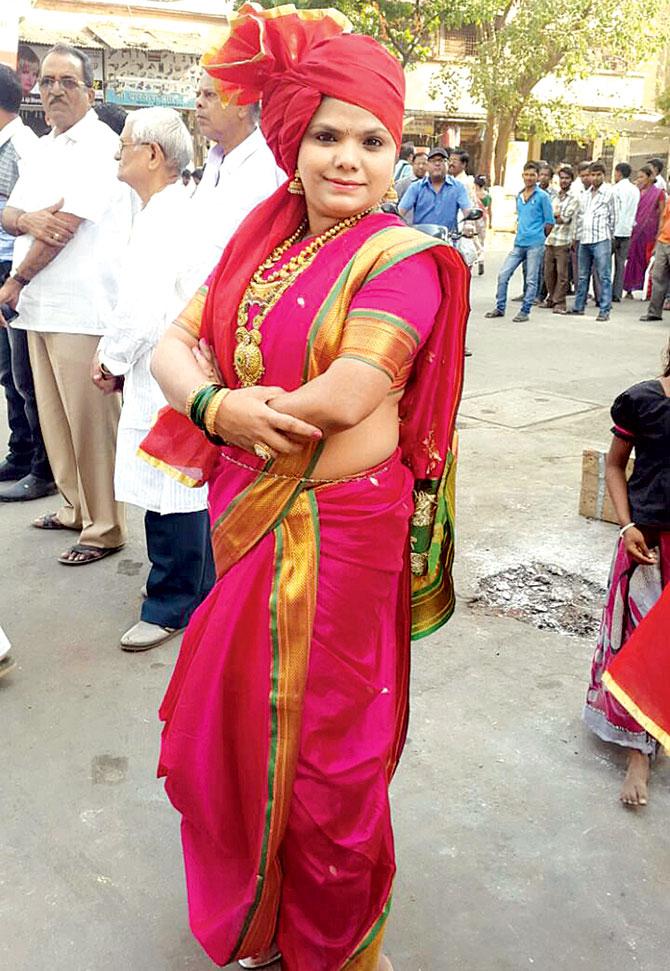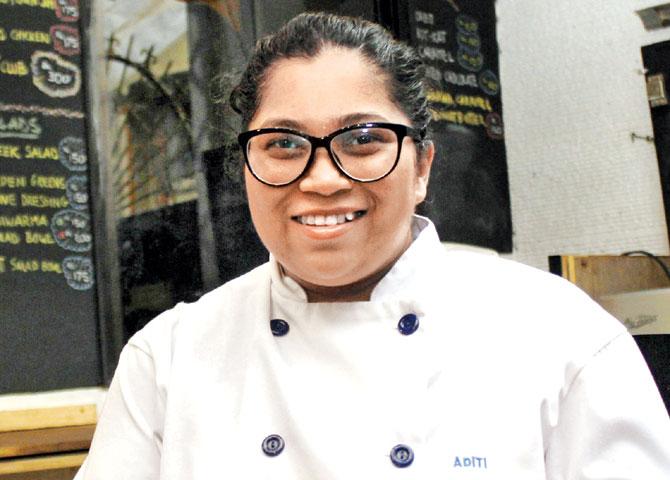Among Mumbai's original communities, the Aagris boast of a spice-rich cuisine, that may be finding takers at a new Lower Parel eatery

Chef Kavita Patil and co-owner Hari Kotian at the Aagri Culture Express kitchen. The food is true to tradition and cooked on low flame in clay pots
 The pungent smell of fish and curry, like coastal evening breeze, greets us when we push the glass door and step into the recently opened Maharastrian eatery that serves Aagri cuisine, Aagri Culture Express.
The pungent smell of fish and curry, like coastal evening breeze, greets us when we push the glass door and step into the recently opened Maharastrian eatery that serves Aagri cuisine, Aagri Culture Express.
Sons of the soil, the Aagris trace their history back to the original 26 villages of Mumbai, when the land where Bandra and Andheri stand today was a mangrove jungles. Yet, their cuisine hasn't gained the urban patronage that Malvani and Koli food has. But, that might not be too far away.
Chef Kavita Patil and co-owner Hari Kotian at the Aagri Culture Express kitchen. The food is true to tradition and cooked on low flame in clay pots
Sitting modestly on Senapati Bapat Marg, Lower Parel — the hub for corporate offices, shopping malls and hotels — next to Asian, Middle Eastern restaurants and French patisseries, Aagri Culture Express feels like the outsider out to prove a point.
Chef and co-partner Vikrant Patil apologises for not meeting us in the morning. "I was at Sassoon Dock. That's where you get the freshest catch — bombil, pomfret, prawns, mandeli, surmai, halwa. Ghol is a delicacy," says the Sion resident, whose great grandfather owned salt pans in Sion.
"During the British era, the community gave up most of its salt pan land to the government and took to farming. Today, the Aagris are settled in Thane, Dahisar, Diva Dombivli and Panvel," he says. Taking a dig at his community, he adds, "We love our gold. We don ourselves with rings on all fingers, chains and bracelets."
The grin doesn't fade when we bring up the tough competition he faces from the neighbouring eateries.
"In the one month we have been open, we've already got repeat customers. Though most office-goers enjoy this cuisine, they have asked us to go easy on the spice," says Vikrant, who opened the restaurant with childhood friend and restaurateur, Hari Kotian. "I was vacating this spot as my Asian eatery, Wok Hei, was moving to a larger space. That's when the idea of opening an Aagri restaurant came to us," says Kotian.
Deepa Patil in a traditional feta for the opening of an Aagri temple. The women of this community don turbans at all religious processions.
"Having been in the hospitality industry since I was 16, I knew Aagri food would work. To ensure we served traditional fare, we got clay pots specially made at Dharavi's kumbharwada," he says. He had to bring in low-flame burners, since this particular cuisine rests its flavours on slow-cooking.
It's not that you won't find Aagri food elsewhere in Mumbai. But, says Deepa Patil, a cook show host on a Marathi channel, who has also authored a book on Aagri food, the eateries are limited to dhabas on the highways that run through Panvel and Thane and their authenticity is questionable.
"Finally, someone has had the guts to serve our cuisine to the city," says the 36-year-old, who also dreams to open her own Aagri restaurant. Television channels, she says, call her to make Kohlapuri dishes, "but I insist on featuring Aagri food," says Deepa. Her book which offers recipes, too, was an effort to document the cuisine. Two hundred copies, she adds, have been sold since the January launch.
A community effort
Setting up the restaurant though, Vikrant will tell you, is about getting the whole community to rally around the idea. The ukadichi bhakri (rice rotis) come in twice a day from a home chef at Worli village, who has a home-delivery service. The aged tamarind and kokum (which give the tangy zing to the trademark curries) come in from Alibag. The basic recipes, Vikrant has sourced from sister Kavita Patil. The Aagri masala is all made fresh in the kitchen.
The non-veg thali at Aagri Culture Express includes fish, mutton curry, roti and bombil chutney
Most dishes have seafood, chicken or mutton, while the gravy is a watery broth. "But, it's dense in taste," explains Vikrant, a former math tutor, who along with his sister, Kavita, and her husband Jaywant, head a team of seven cooks. Kavita adds that, unlike Kolis and Malvanis, the Aagris roast coconut for the curry. "And, we don't use coconut milk either. Our food habits are similar to the Kolis," she says.
While Kavita has shared the family recipes and is responsible for the pickle and papad, Jaiwant is the master of Bombay duck chutney. "Aagris eat non-vegetarian food like the sea is going to dry up. They have a spicy palate and don't care for dessert. In our chutneys, even the onions are roasted to lessen the sweetness," explains Vikrant. Their menu boasts of khadiche mutton (a sukka dish that loosely translates as hogger's dish), Aagri vada (made of rice flour) and two curries — a tangy tamarind gravy for fish, and an Aagri masala and roasted coconut curry for mutton and chicken.
Harvesting tradition
This cuisine, like with most agrarian communities, is linked to the soil. With Navratri around the corner, Aditi Keni says, members will put soil around a metal kalash and sow nine to 14 types of seeds. Keni, founder of Eatyadi, a private dining firm, who runs Eatyadi, a private catering service, says, "On the last day, we harvest the crop and serve it as prasad. Our traditions are simple, minus brouhaha."
Aditi Keni, co-founder of Eatyadi
Prasad should reflect what's important to the community. And thus, meat also gets offered to the goddess. Tirpan, a dish of teta (goat liver) and kalegi (kidney) tossed in coconut, is served as prasad and later distributed, says Deepa. Other community dishes include the navsatchye mutton, in which the mutton is cooked as a whole chunk. "We even make patkora, which is fish in turmeric leaf, similar to the Parsi patra ni machchi," adds Deepa.
While the chefs at Lower Parel are trying to introduce the world to the Aagris, Kenis is bridging the gap by walking the other way — modernising dishes to take them to a wider audience. Keni, who remembers her grandfather tasting every raw vegetable before buying it, has found ways to incorporate home food in fancy dinners.
"For private sit-downs, I often serve a dish called patole, which is similar to udki cha modak stuffed with coconut, jaggery and elaichi. I add a savoury twist by doing a fish filling," she says, adding that she once even served mutton Aagri masala samosas. "People loved the taste, but couldn't place the spices till I told them."
 Subscribe today by clicking the link and stay updated with the latest news!" Click here!
Subscribe today by clicking the link and stay updated with the latest news!" Click here!









